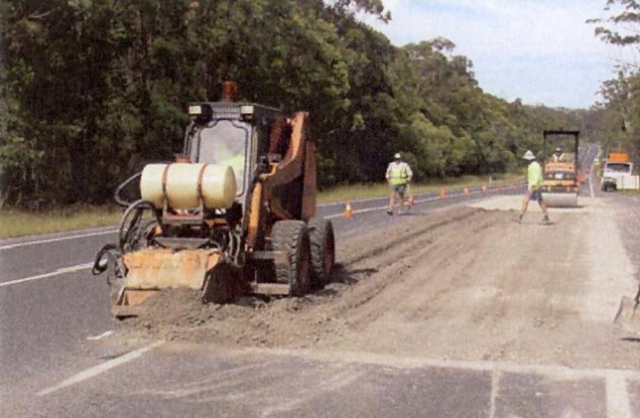Although there are viable options to ensure long-term pavement rehabilitation of full sections of road pavements, patching of flexible pavements is a commonly used tool for the maintenance of pavements in Australia and throughout the world.
The Maintenance Problem
Throughout Australia and the world, the problems for Road Managers are consistent; pavements are ageing; a significant number of pavements are either approaching or have exceeded their effective design lives and are now composed of materials that have deteriorated and lost their original properties; and these pavements are also usually too thin for their present required loadings.
The upkeep of these pavements is becoming more difficult due to this greater need for maintenance or upgrading, roads are perceived by road users as not being adequate and being in a state of decline, and all related costs such as labour, stone, materials, bitumen, fuel, trucking and so on are increasing rapidly.

Patching as a Maintenance Option
Most patches fall into three main categories; granular, stabilised and asphalt. Granular and stabilised patches usually range in size from as little as 10m² up to 500m², with greater areas usually considered as reconstruction rather than pavement maintenance patching. Asphalt patches usually range in size from as little as 2-3m² to 300m². Asphalt patches much greater than 300m² are relatively uncommon due to high costs.
The construction methods for these types of patches can vary significantly after the setting up of the common traffic control phase.

Construction and Design Limitations of Patching as a Maintenance Tool
Due to their small size, light rollers are usually used for patches for practicality, influencing the depths of patches to be typically within the range of 150mm to 200mm. This depth is generally insufficient to provide the appropriate structural thickness required for the pavement to withstand traffic loading over a long-term period.
Not to be confused with standard stabilisation of larger sections, stabilised patches specifically result in construction practices that cause several problems. Because patches are a much smaller size, the cement or other binder additive is usually spread by bags and by hand and the mixing is undertaken using a mixing head fixed to a skidsteer machine. This practice has issues relating to poor mixing of product.
Since, by their intrinsic nature, patches are relatively small in area, during construction there is a high level of activity of the construction plant on the existing pavement adjacent to the patches. Although these areas may originally show less signs of distress than the area being patched, these adjacent areas are usually themselves in a precarious position coping with existing traffic loadings. The extra construction traffic stress around newly constructed patches invariably cause failures in the surrounding existing pavement. This is a common feature of patching and can begin to appear within months of the patch construction.
Since patches only address localised areas in the road pavement length, it is a continuing process rehabilitating the sections between patches with further patches, as new areas of distress occur in the overall pavement.
Other Maintenance Options
Although rehabilitating pavements using stabilisation and pavement recycling techniques has been embraced by many as a viable alternative, this option has yet to recognise its full potential. And so, many managers of pavement networks are caught in this transition position, where they are under political pressure to maintain their pavements to acceptable levels for the owners, users and/or public, but they have static or decreasing funds, and their traditional maintenance methods are no longer financially feasible. This has resulted in recent times in an increase in the use of patching by many network managers to overcome this dilemma in the short term.
When undertaken properly, stabilisation and pavement recycling offer pavement rehabilitation that is long-term, cost effective, environmentally friendly by rejuvenating the existing pavement, and efficient by addressing areas of pavement over entire roads or large sections of roads.

How Can Prequalification Help?
To assist managers who are in a transition period or entrenched in a cycle of ongoing patching, there are prequalification and accreditation schemes in place by road authorities and industry bodies to help procurers directly engage with reliable and trustworthy contractors.
For example, TfNSW have in place a Registration Scheme for Construction Industry Contractors to ensure that managers can quickly engage with qualified contractors who have sufficiently demonstrated capability to undertake pavement rehabilitation to meet modern-day construction and design standards. Specifically, the Z1 category provides qualification for ‘stabilisation by insitu method using specialist machines.’
AustStab and ARRB have collaborated to create a list of accredited contractors who have a complete verified understanding of stabilisation process and theory, as well as demonstrating success with real-life completed projects.
The aim of the accreditation scheme is to provide a consistently higher quality product than other contractors and indeed a more competitive alternative to patching programs for the consideration of road managers.
Currently, there are thirteen accredited contractors representing all states of Australia that can be relied upon by road managers seeking alternative and more efficient pavement maintenance options compared with patching programs.
References:
AustStab (2010), A Review of Patching as a Pavement Maintenance Tool, 24th Australian Road Research Board Conference, Melbourne, Australia 2010. Accessed 21 March 2022 at https://www.auststab.com.au/wordy/wp-content/uploads/2017/01/review_of_patching_pavement_as_maintenance_tool.pdf














